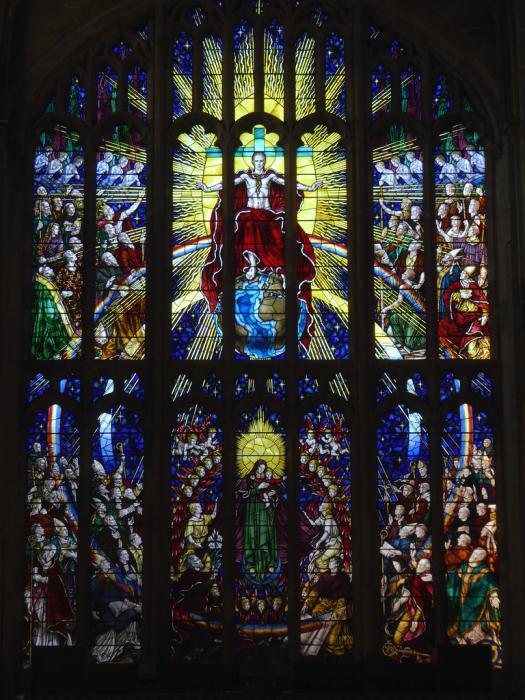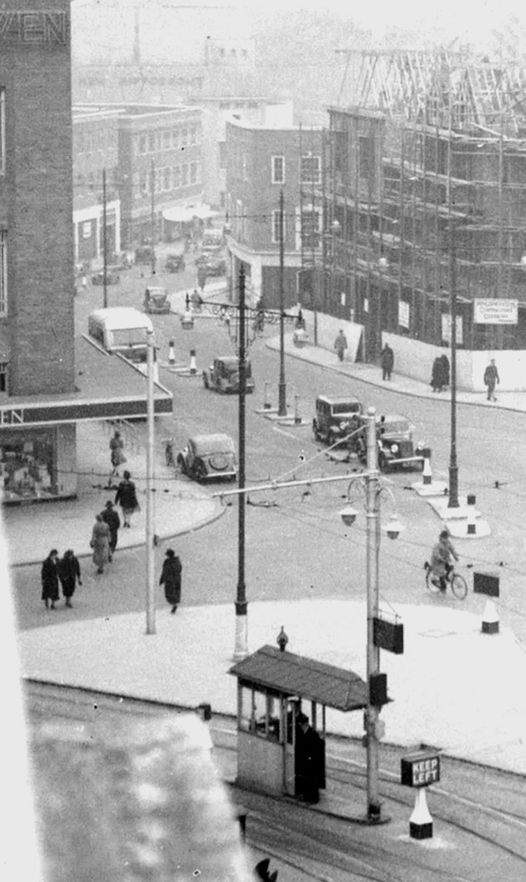Choirboy
Bicester
|
181 of 196
Thu 12th Oct 2023 3:08pm
I recall seeing the west window of Holy Trinity boarded up that bfta shows in 1950, (when I would be just about 2) but the window had been replaced by the time of the 1953 photo. Does anybody know offhand when it was put back? |
|
Streets and Roads -
Trinity Street
|
NeilsYard
Coventry
|
182 of 196
Thu 12th Oct 2023 3:10pm
I don't think it was replaced Choirboy - I think they just boarded it up to preserve the Stained Glass during the Bombing. |
|
Streets and Roads -
Trinity Street
|
Helen F
Warrington
|
183 of 196
Thu 12th Oct 2023 3:29pm
I don't know which glass in the old buildings was removed and which was just protected. Maybe it was only the ancient glass in St Michaels that was shipped out? |
|
Streets and Roads -
Trinity Street
|
|
Choirboy
|
184 of 196
Thu 12th Oct 2023 3:54pm
|
|
Prof
Gloucester
|
185 of 196
Fri 13th Oct 2023 12:56pm
Trinity the West Window. This is another stunning window which replaced Victorian glass blown out in November 1940. Designed by portrait artist Hugh Easton and dedicated in 1955.
 |
|
Streets and Roads -
Trinity Street
|
|
Choirboy
|
186 of 196
Fri 13th Oct 2023 1:14pm
|
|
Prof
Gloucester
|
187 of 196
Sun 15th Oct 2023 8:42pm
Thanks Choirboy, I was 17 in that year. I thought the image would just make the post but took me some fiddling to post it! |
|
Streets and Roads -
Trinity Street
|
NeilsYard
Coventry
|
188 of 196
Wed 15th May 2024 9:38am
Not sure I've seen this one before - Timothy Whites going up.........

|
|
Streets and Roads -
Trinity Street
|
rocksolid
Bristol
|
189 of 196
Thu 23rd May 2024 10:41pm
Seeing this reminds me of another photo from c 1939:
Does anybody know when/why the top two floors of the middle section, numbers 13-21, were removed? I understand that 17 was originally Telephone House but did it house an exchange or was it just administrative offices? I guess the newer much bigger exchange in LIttle Park Street was built in 1950s?
|
|
Streets and Roads -
Trinity Street
|
Helen F
Warrington
|
190 of 196
Fri 24th May 2024 9:54am
Apart from it still being there in 1953 I don't know anything about it, sorry. |
|
Streets and Roads -
Trinity Street
|
Rob Orland
Historic Coventry
|
191 of 196
Fri 24th May 2024 10:02am
I've checked my photos, and the earliest I can find is 2004 - it was already gone then. I do recall something being mentioned about it, but I can't now recall the exact reason. It might have had something to do with problems with leaks, but I can't be sure. |
|
Streets and Roads -
Trinity Street
|
PhiliPamInCoventry
Holbrooks
|
192 of 196
Fri 24th May 2024 1:37pm
Hello,
There were two Coventry central telephone exchange operations. Greyfriars, in Greyfriars Lane, and another central one. They were replaced by the current automatic exchange located in Much Park St.
The previous exchanges were manually connected by telephone operators.
Could the now demolished high rise in Trinity St, be the other manually operated exchange? |
|
Streets and Roads -
Trinity Street
|
Positively Pottering
East Midlands
|
193 of 196
Fri 24th May 2024 3:07pm
17 Trinity Street -Telephone House was the Coventry Telephone Managers administration centre with several Engineering Control Centres namely External Works Control and Pole Erection Unit Control sited amongst the many clerical departments.
It occupied the upper floors of Trinity Street above the retail outlets from the ground floor main entrance at number 17 up along Ironmonger Row and Cross Cheaping to the junction of Palmer Lane and The Burgess.
Coventrys central telephone exchange Head Post Office (HPO) was located at the rear of the General Post Office in Hertford Street with access via Greyfriars Lane which housed the Strowger exchange equipment and the operators manual switchboard.
Greyfriars Automatic Telephone Exchange (ATE) was built in the 1950s thus making HPO largely redundant save for a number of clerical functions and the manual switchboard was resited on the upper floors of the new exchange.
By the mid 60s it was clear that due to massive expansion of the network there was a need to build another exchange in the city centre and this was constructed at the rear of Greyfriars ATE which was the staff car park at the time.
This exchange was named Leofric ATE and was commissioned in the early 70s and can be seen clearly in Greyfriars and Salt Lanes.
Furthermore with the expansion of the telephone network there was a need for increased administration premises and as a result several floors of Station Tower were used along with numbers 2 and 4 Copthall House.
The now demolished multi storey building in Much Park Street/Little Park Street that Philip mentioned was Coventry City Council owned.
Btw, there were two Telephone Engineering Centres (TECs) in Coventry where Section Stock Stores, Motor Transport Workshop together with engineers welfare facilities were housed, Torrington Avenue and Mason Road. |
|
Streets and Roads -
Trinity Street
|
PhiliPamInCoventry
Holbrooks
|
194 of 196
Fri 24th May 2024 3:59pm
Thank you for a brilliant response to my query, where another member had asked info regards the now removed higher floors of that building.
Thank you.
I've a personal interest in this, as my mum & dad's telephone number in the fifties was Greyfriars 759, a shared line, with a manual operator, no dial phone. A year or so before, having a dial phone with a Coventry number, their Greyfriars 759 became 1759. Still manual operator. |
|
Streets and Roads -
Trinity Street
|
Positively Pottering
East Midlands
|
195 of 196
Fri 24th May 2024 4:57pm
|
|
Streets and Roads -
Trinity Street
|